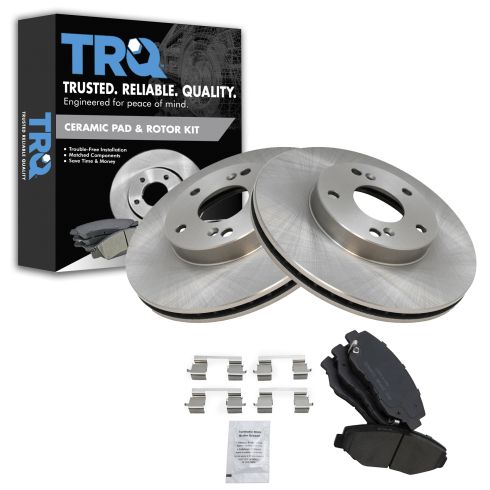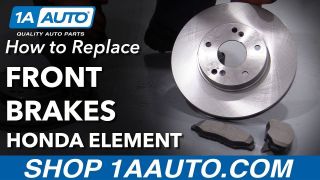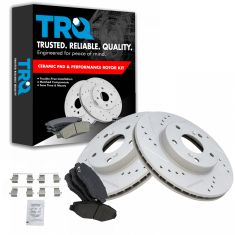1ABFS00814-Honda Acura Front Ceramic Brake Pad & Rotor Kit TRQ BKA10850

Replaces
2015 Honda Civic EX Front Ceramic Brake Pad & Rotor Kit TRQ BKA10850

Product Reviews
Loading reviews
4.78/ 5.0
37
37 reviews
Nakamoyo brake parts
March 14, 2017
Great quality parts and shipping was fast. Rotors matched perfectly and pads feel great now when braking.
brake kit
July 12, 2017
Parts fit as described. Never heard of brand but will see how they wear.
Messed up order
August 14, 2017
My parts would have been fine if all came at once!!! the order got separated some how on a three item order. this is the second time, three strikes and i am done!!!!!
Excellent Product, prompt arrival
March 12, 2018
I ordered the parts planning to install them 2 weekends from when I ordered them, but they came so quickly, I was able to get them in that same weekend. Correct part and easy installation.
Great
July 26, 2018
This product was great and I will definitely buy this product again and recommend it to other people. Fast shipping also.
Another good A-1 Auto experience
September 26, 2018
Not an expert but I am pleased with the quality of the brake kit. I have ordered from A-1 Auto before and I am yet to be disappointed. Obviously time will be the biggest test for any part but I am very pleased thus far.
Great value, quality
November 7, 2018
Tremendous value and quality at a really good price.
Front Rotors and Brake Pads Kit
November 14, 2018
I'm thoroughly happy with the front rotors and brake pads kit that I purchased from 1A Auto. Delivery was prompt and they fit my vehicle beautifully. The 1A video installation instructions made the job simple and efficient. My vehicle's braking response is now quick, secure and quiet. It feels like I have a new car! Thanks 1A for quality auto parts.
Brajes
November 23, 2018
Love them. Jaja so smith whit garranty nice ice very very nice
Great product
December 17, 2018
This product was exactly what I needed! It was affordable, good quality, and shipped quickly. Thank you so much!
Fast shipping, good quality
September 17, 2019
Really happy with this purchase, parts arrived on time perfect fix and good quality ceramic brakes
Front Brake Pads and Rotors.
March 22, 2020
Good Quality parts that fit right. and arrived on time.
High Quality Parts
April 1, 2020
Well pleased with placing my order and also received help online to make sure the right parts were ordered for my vehicle.
Fast shipping
and the prices were great.
Awesome
November 18, 2020
My parts got home really fast, and really cheap , my best place for parts
Pretty good honestly
January 11, 2021
I havent had them on too long maybe a month or 2 but for the price they do what they should stop good not too loud not too much dust way cheaper than most of the ones I was looking at shipping wasnt the best the box was dented but I mean everything was good inside so cant complain 9/10 product so far
quality at a great price
January 18, 2021
I have used this company on lots of brake jobs. The quality an the price are great and 1AAuto always ships promptly. I would and have recommended their parts to any one
Great purchase
April 4, 2021
Break rotors and break pads and transmission mounts came in time, fit perfectly.
Great brakes
April 17, 2021
The brakes work good. I do not have any issues with them. Came with all hardware and grease. Good price and my civic stops good
A plus
October 10, 2021
Exact fit just like it said. Came with new brake pad clips for the caliper bracket and brake grease.
October 27, 2021
Perfect fits I'm happy with my new front brakes
November 28, 2021
High Quality Parts. Very Happy with my purchase.
Great
December 29, 2021
Great
January 20, 2022
Great product!
Great Price!
Great experience!
January 27, 2022
Great price! Great performance!
So far so good
February 15, 2022
I bought this products two weeks ago . I am happy. They work properly
Great
June 2, 2022
Always shipped fast fit great. And when 1 rotor was lost in shipping due to how they packaged it, they sent another one to me hassle free.
Awesome
July 17, 2022
This kit works great for 2012 Honda Accord lx.
I feel BEST ROTORS AND BRAKES!
August 8, 2022
Extremely 1st class, Provides optimal performance while keeps its great looking aspect. Super thankful i got these parts from 1aAuto! #1
Priced right, complete front brake replacement minus calipers
October 17, 2022
Product came complete, 2 front rotors and pads with all shims and grease. I used the grease on all contact points of pad to caliper, and reapplied new grease to the slides inside the boots. No wear issues to be noted from old pads. Worn evenly, but rotors were warped.
Sadly, now when I reverse, the front pads sing me the song of non oem pads on a Honda.
October 24, 2022
So far so good no issues
January 20, 2023
work great no complaints. eassy to install
June 21, 2023
Parts all fit good and came in a timely manner
July 23, 2023
Great price. Operates as promised. No issues. Definitely recommend
Highly Recommended
September 27, 2023
Excellent part works pretty well. Will definitely shop more with 1AAuto.
April 2, 2024
great!
Acura breakes and rotors
June 6, 2024
Great parts fitted like a glove would recommend to anyone looking for the same
Brake rotors and pads
July 6, 2024
I like all your products but was sene wrong rotors and pads will from now on when ordering include vin number then I will receive the correct ones you were out of the correct pads this is second time you were out of the parts for one of my vehicles
Customer Q&A
Can the rotors be resurfaced?
September 22, 2016
10
Yes they can if they ant worp.
September 22, 2016
Robert R
10
Probably as long as the legal minimum thickness is left after machining, however by the time you pay labor and shop time Ive found it cheaper to buy new rotors
September 22, 2016
Ronald S
10
There is plenty of room to resurface these rotors after at least one change of pads.
September 24, 2016
Mike C
10
Resurfacing is not recommended. Leaving less metal to dissipate braking heat will only result in warped rotors again.The answer to your question is yes, they CAN be machined but at the cost of new replacements, its not always a financial benefit
September 26, 2016
Brian F
Will this fit my lx 2013 civic?
February 12, 2020
10
Thank you for contacting us. This part is not listed to fit the Honda Civic LX model.
February 12, 2020
Peter L
Are the rotors coated?
January 14, 2021
10
These rotors are not coated.
January 14, 2021
Corey M
Would they fit my 2008 Accord japan made?
October 7, 2022
10
This part will not fit your vehicle, but we may have a part that is listed to fit.
Please enter your vehicle's year make and model in the search bar at the top of the page. This will display parts guaranteed to fit your vehicle. Just be sure to verify all of the information shown in the Vehicle Fit tab before ordering.
October 7, 2022
Ricale A
Will this fit a 2006 Honda Accord L4 coupe 2.4l (2 door)?
January 8, 2023
10
This will not fit your couple model.
Please enter your vehicle's year make and model in the search bar at the top of the page. This will display parts guaranteed to fit your vehicle. Just be sure to verify all of the information shown in the Vehicle Fit tab before ordering.
January 10, 2023
T I
Will this fit my 2012 honda accord se?
June 7, 2023
10
Yes, this part will fit your 2012 Honda Accord, provided that your vehicle is an LX L4 2.4L (US Built Model)
June 8, 2023
Jean O
What is the outside diameter of these rotors?
June 16, 2023
10
Actual Measurements are not listed or available. Our parts are exact replacements for your vehicle's OEM parts. As long as your vehicle specifications match up with our listing, these parts will directly fit and function like the originals.
June 17, 2023
Kemal S
Will this fit my 2008 Honda accord 3.5L ex-l ?
July 25, 2023
10
No, this kit will not fit your vehicle. Part number BKA11300 is correct for your vehicle.
July 27, 2023
Andra M
10
Yes it will
August 4, 2023
JESUS A
Will this fit my 03 accord ex 2.4l sedan Japan built?
August 4, 2023
10
Yes it will
August 4, 2023
JESUS A
10
Yes, this part will fit your vehicle.
August 4, 2023
Emma F
10
Yes
August 31, 2023
Pedro S
will this fit my 2006 accord 3.0?
March 15, 2024
10
This part will not fit your vehicle, but we may have a part that is listed to fit.
Please enter your vehicle's year make and model in the search bar at the top of the page. This will display parts guaranteed to fit your vehicle. Just be sure to verify all of the information shown in the Vehicle Fit tab before ordering.
March 16, 2024
Kemal S
Honda is a registered trademark of Honda Motor Co., Ltd. 1A Auto is not affiliated with or sponsored by Honda or Honda Motor Co., Ltd.
See all trademarks.
















